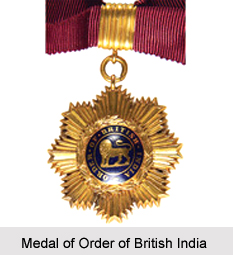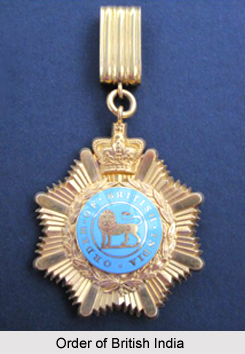 The Order of British India was an order of merit that was granted by the British East India Company. It was established on 17 April 1837 and was bestowed to members of the British Indian Army for long, faithful and honourable service. After the culmination of the Sepoy Mutiny in 1857- 1858, the East India Company and the Presidency Armies in British India came under the administrative authority of the British Empire in India. Consequently, the Order of British India was included as a part of the British honours system in the years 1859. However, the order of merit was disused after the partition of India and the Indian independence in the year 1947.
The Order of British India was an order of merit that was granted by the British East India Company. It was established on 17 April 1837 and was bestowed to members of the British Indian Army for long, faithful and honourable service. After the culmination of the Sepoy Mutiny in 1857- 1858, the East India Company and the Presidency Armies in British India came under the administrative authority of the British Empire in India. Consequently, the Order of British India was included as a part of the British honours system in the years 1859. However, the order of merit was disused after the partition of India and the Indian independence in the year 1947.
Medal of Order of British India
The medal of the Order of British India was generally bequeathed in 2 classes, namely the first class and the second class. The recipients of the Medal of the first class were allowed to utilise the title Sardar Bahadur (heroic leader) and the recipients second class were permitted to use the title Bahadur (hero). The receivers of both classes of medals also used the post-nominal letters OBI.
The Order of British India was normally presented for distinguished service on a particular campaign. However it was also granted to officers for providing service between 20 and 30 years.
 Recipients of Order of British India
Recipients of Order of British India
The list of the recipients of the 2 classes of medals of the Order of British India are mentioned as below-
First Class Medals of Order of British India -
* Honorary Captain Sardar Bahadur Ranjit Singh Khatter OBI (1st Class, World War II)
* Sardar Bahadur Lt Col Dr Gopal Singh Chawla OBI (1st Class 1946)
* Subedar Major Sardar Bahadur Singh Atwal, OBI (1st Class, World War 2)
* Captain Sardar Bahadur Raja Larasahib Khan, OBI (1st Class 1939)
* Captain Sardar Bahadur Hazara Singh Bahad, OBI (1st Class)
* Honorary Captain Sardar Bahadur Mihr Din, OBI (1st Class 1918)
* Captain Sardar Bahadur Muhammad Ismail, IOM (3rd Class 1897), OBI (1st Class 1917)
* Honorary Captain Sardar Bahadur, Mihr Din, OBI (1st Class)
* Honorary Captain Sardar Bahadur Shankar Dass Randhawa, OBI (1st Class)
* Honorary Captain Sardar Bahadur Dr. Kartar Singh Grewal, OBI (1st Class 1939)
* Captain Sardar Bahadur Bhola Singh Gulia, OBI (1st Class)
* Captain Subedar Bahadur Nar Gurung, MC, OBI (1st Class)
* Lieutenant Colonel Sardar Bahadur Anop Singh, OBI (1st Class)
* Lieutenant Colonel Sardar Bahadur Aman Singh Jodha, OBI, IOM
* Lieutenant Sardar Bahadur Ahmadullah Khan, Khan Bahadur, IOM, OBI (1st Class 1 January 1909)
* Colonel Sardar Bahadur Hashim Ali Khan, Nawab Mir Hahsim Nawaz Jung, SB, OBI (1st Class 1897)
* Captain Sardar Bahadur Kalandar Khan Khattak of Jalozai Noshera, OBI (Chief of Khattaks and Zailidar of Peshawar, Dehli and Lahore)
* Captain Sardar Bahadur Zain Muhammad Khan, OBI (1st Class)
* Subedar Major Sardar Bahadur Oomar Khan, OBI (1st Class)
* HE Lieutenant Colonel Sardar Bahadur Raja Atta Ullah Khan, OBI (1st Class 1868) Subedar Major/Captain Sardar Bahadur Bishon Singh Kathait, OBI (1st Class, World War 2)
* Captain Sardar Bahadur Rup Singh, OBI (1st Class)
* Captain Sardar Bahadur th. khushal singh ugrawat, OBI (1st Class)
* Honorary Captain Sardar Bahadur Talib Shah, OBI (1st Class 1919)
* Captain Sardar Bahadur Bhanwar Singh Shekhawat, MBE, MC and Bar, OBI (1st Class) of Prithvipura
* Subedar Sardar Bahadur Hari Singh Thapa, OBI (1st Class)
* Subedar Major Sardar Bahadur Jodh Singh, OBI (1st Class)
Second Class Medals of Order of British India -
* Captain Bahadur Inayat Ullah Asmie, OBI (2nd Class)
* Sardar Subedar Bahadur Humail Khan, OBI (1st Class)
* Lieutenant Bahadur Mohammed Abdul Hafiz, OBI (2nd Class 1917)
* Sub Major Bahadur Syed Nazar Mohammad Shah, OBI (2nd Class)
* Captain Bahadur Syed Rasool Shah OBI (2nd Class)
* Subedar Major Bahadur Raja Nazar Muhammad Khan, OBI (2nd Class), IOM
* Subedar Bahadur Niaz Muhammad Khan, OBI (2nd Class), IOM
* Colonel Rao Bahadur Thakur Balu Singh ji Inderpura, OBI (2nd Class)
* Subedar Bahadur Richhpal Singh, OBI (2nd Class)
* Subedar Bahadur V. Parangusam Naidu OBI (2nd Class) RIASC
* Subedar Major Bahadur Jagindar Singh, OBI (2nd Class), IOM (2nd Class)
* Subedar Bahadur Maima Singh OBI (2nd Class), IOM, 15th Bengal Infantry



















